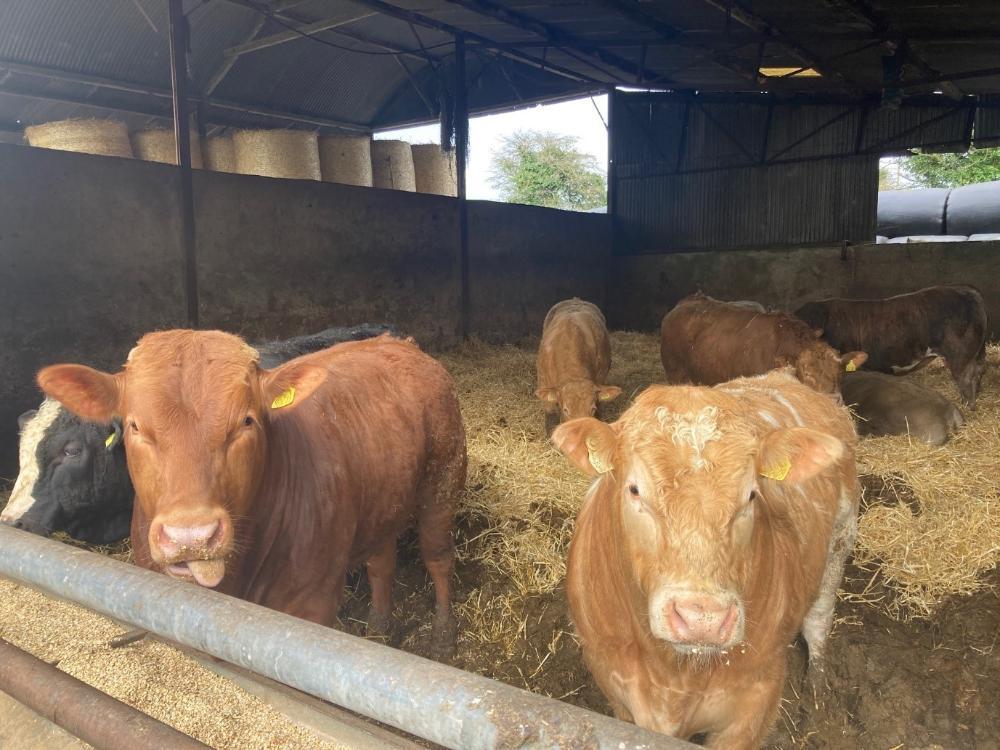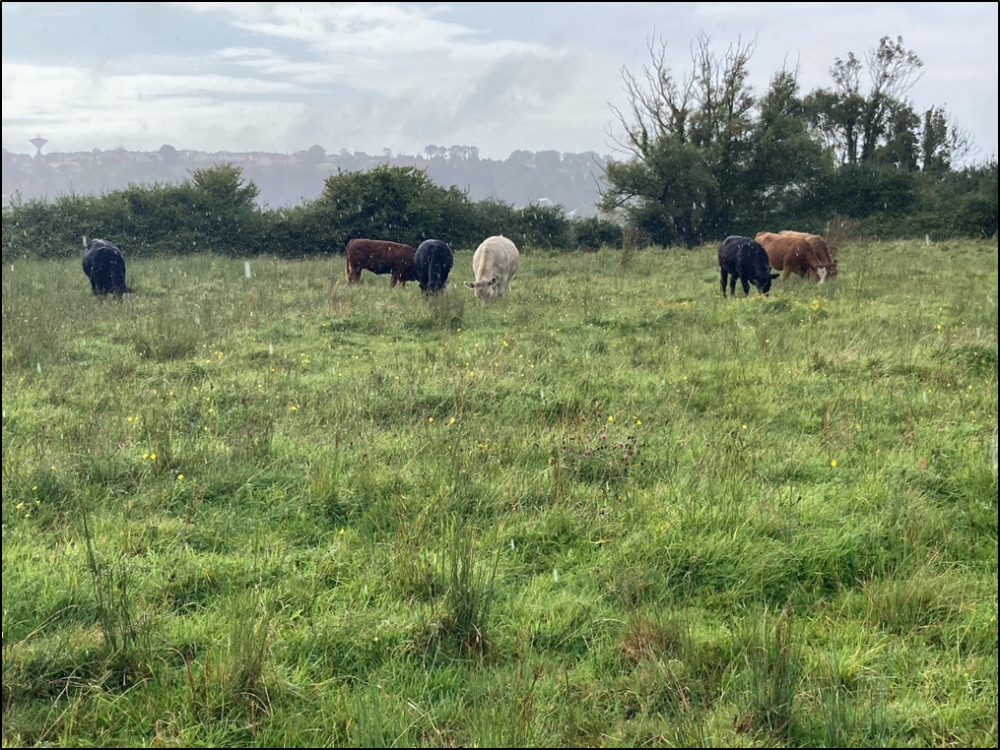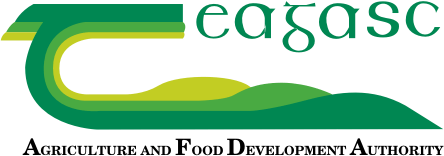05 April 2023
Future Beef Update: Matching the bull with the cow and using sexed semen

Eamon and Donnchadh McCarthy – a father and son team – operate a suckler-to-beef enterprise in Youghal, Co. Waterford, with bulls finished under 16 months and heifers at 22 months.
Farming 45.6ha on a part-time basis, 31 spring and 18 autumn-calving cows are kept on the farm. 100% AI is used, which allows them to pick the best maternal and terminal bulls available.
All calves are registered by DNA, which means that genomic evaluations are available for heifers well before they are bred at 15 months of age. Once the heifers are genotyped, Weatherbys is contacted to obtain the myostatin (double-muscling gene) status. This indicates if heifers are likely to produce double-muscled calves with heavier birthweights or not. All of this information helps to make more informed breeding decisions, with AI bulls then selected to suit individual heifer and cow needs.
Both the autumn and spring breeding seasons are restricted to six weeks, which is useful for labour management. However, this creates a challenge for sourcing replacements, as there is a replacement rate of 25-30% instead of the standard 20%. Eamon and Donnchadh have therefore decided to use sexed semen for the first time this year. They plan to breed all maternal cows that come bulling in the first three weeks of the breeding season to a sexed Simmental bull (SI4147). The main difference with using sexed semen is that females must be bred at 14-20 hours after the start of standing heat to achieve the best conception rates.
Eamon and Donnchadh are using Simmental bulls and an Aubrac bull as their maternal bulls for breeding replacements this spring. The average Eurostar value of the bulls being used is €192. As the herd Replacement Index is €123, the potential average replacement value of any heifer calves will be €158.
Table 1: Replacement sires for use in 2023
| AI Code | Breed | Replacement Index | Carcass (kg) | Milk (kg) | Calving interval (days) |
|---|---|---|---|---|---|
| AU4683 | AU | €217 | 18.1 | 3.8 | -7.53 |
| SI4147 (sexed) | SI | €191 | 33.3 | 9 | -6.1 |
| SI2469 | SI | €190 | 14.8 | 7.2 | -7.32 |
| SI4350 | SI | €171 | 24.7 | 7.9 | -3.24 |
| Average | €192 | 22.7 | 7 | -6 |
The terminal bulls are mainly Charolais, with one Limousin bull being used and they have an average value of €146 on the Terminal Index.
Table 2: Terminal sires for use in 2023
| AI Code | Breed | Terminal Index | Carcass (kg) | Conformation (1-15 scale) |
|---|---|---|---|---|
| LM2014 | LM | €154 | 28.9 | 2.45 |
| CH8535 | CH | €157 | 42.1 | 2.28 |
| CH7503 | CH | €137 | 39.9 | 2.22 |
| CH8571 | CH | €135 | 35.5 | 1.49 |
| Average | CH | €146 | 36.6 | 2.11 |
In the below video, Eamon and Donnchadh pick bulls to complement their cows ahead of breeding.
For those considering using sexed semen in their suckler herds this year, Aisling Molloy, Future Beef Advisor, outlined the steps required in the below article.
Also read: Using sexed semen in the suckler herd
Performance
The 2022 spring born bulls (24) have all been gradually built up to an ad-lib diet, consisting of approximately 5kg of home-grown barley, 6kg of a 14% CP ration and >70% DMD silage. They are housed in a straw-bedded shed and have constant access to clean water, which is checked daily to make sure that troughs are working properly and are cleaned out. There are four groups of bulls and they are divided by weight. The average date of birth is the 16th February 2022 and this only ranges from February 2nd to the 7th of March.

They were weighed on the 25th of March and were an average weight of 577kg (range 502kg to 722kg). They gained 2.41kg/day since the last weighing on the 11th of February. Drafting for slaughter is expected to start from April by weight and fat cover. The bulls will continue to be weighed and handled monthly to assess both weight and fatness.
Biodiversity
The farm, which consists of three blocks – including 4.6ha in winter barley and 11.8ha in Special Area of Conservation (SAC) – is making a good contribution to biodiversity already, as there are many mature hedges and trees in-situ. Hedges over 1.5m in height are desirable, as they provide suitable nest sites for birds with cover above and below their nests.
Escaped hedges (untopped/treelines) naturally contain flowering thorn trees. Topped hedges may contain individual flowering thorn saplings or tress if they are retained. These provide flowers for bees and fruit for birds and small mammals. New thorn saplings provide song-posts and thorn trees for the future.
Farmed landscapes with an average field size of less than 5ha provide numerous benefits such as shelter, networks for nature and corridors of movement for birds, bats, bees and butterflies to move through the countryside. In this case, the average field size can be calculated by dividing the land area in hectares by the number of fields – which are surrounded by permanent biodiverse boundaries. Biodiverse boundaries include hedges, watercourses, and vegetated margins etc., not wire fences.

Field margins also provide important habitats on the farm. In the tillage fields they can be left uncultivated to allow native wildflowers and grasses to grow. In both the tillage and grassland fields on the farm they should be left unsprayed to retain these wildflowers and grass habitats. However, noxious weeds such as docks, thistles, ragwort, common barberry, male wild hop plant and wild oats can still be spot sprayed.
Watercourse margins provide further protection for watercourses to avoid nutrient and sediment loss and allows space for native wildflowers and grasses to grow. All watercourse banks should be fenced on the farm, with margins over 1.5m. There should be no livestock drinking access to any watercourse.
The biodiversity management practices self-assessment tool for linear habitats is useful for assessing your farm. The target score is 8/8 and it helps to identify areas for improvement. In Eamon and Donnchadh’s case, they scored 6/8. They can improve this score by changing the following practices on their farm:
- Not spraying field margins for briar control;
- Fencing all watercourses 1.5m form the top of the bank.
The land on the out farm in Youghal is a protected area by law. Eamon and Donnchadh maintain this extensive grassland by grazing autumn cows on it at a low stocking rate over the summer. There is no organic or chemical fertilisers applied to it, nor any sprays. No silage is cut from it either. The cows thrive well there and there are many positive indicator species present, with no perennial ryegrass which indicates a high-quality habitat.
This article first appeared in the Future Beef newsletter for April. For more information on the Future Beef Programme and to sign up to simiar articles, click here.
